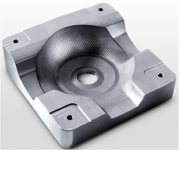
Injection molding is a widely used process for rapidly mass-producing low cost highly uniform mechanical parts. On a cursory level, it is a relatively straight forward process by which molten material (metal, glass, polymer, etc.) is injected into a hollowed-out cavity, cooled down to solidify, and then ejected. This results in the material being permanently shaped to the internal cavity of the mold. This process has been around for hundreds if not thousands of years with the original molds being made out of clay and then broken apart to reveal the finished part. Nowadays most molds are made from steel or aluminum (although low-cost rubber molds are also available) and they typically consist of two plates called the injection mold and the ejector mold, which when combined form an internal cavity. These two components are usually manufactured using conventional machining or electrical discharge machining (EDM), but these methods lack the ability to precisely engrave fine details such as text, logos or other patterns. In this blog we will take a look at how a process called laser texturing is used to overcome this limitation, to allow molded parts to mimic the look of leather, wood, and other materials.
この情報へのアクセスはメンバーに限定されています。ログインしてください。メンバー登録は下記リンクをクリックしてください。

